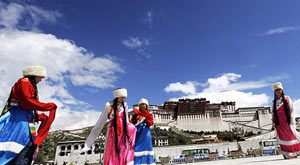Tibet welcomes more visitors
China Daily, March 11, 2014 Adjust font size:
The chairman of the Tibet autonomous region's government said the region is trying to create a world-class travel destination and he expects more travelers from around the world to visit the core area of the Qinghai-Tibet plateau.
Chairman Lobsang Jamcan, in an exclusive interview with China Daily, said the local tourism industry should solve any problems with permits required to enter Tibet. Well-organized planning and designs for tourism facilities are imperative when providing a comfortable environment for travelers, both from China and abroad.
Tibet started to cultivate tourism in the 1980s and last year saw 13 million visitors to the autonomous region, an annual increase of 22 percent. The autonomous region's government has made a priority of dealing with high-end demand from the Beijing-Tianjin-Hebei hub, the Yangtze River and Pearl River deltas, plus Europe and the United States, Lobsang said.
He said Tibet's unique scenery and cultural heritage make it a place many travelers yearn to visit. Destinations such as Mount Qomolangma, known in the West as Mount Everest, and the Yarlung Zangbo Grand Canyon are beyond comparison, the chairman said. Both will be made into national parks, along with Namco Lake and the holy mountain in Ali prefecture.
Tibet is one of the places where people feel closest to the sky, given the region's average altitude of more than 4,000 meters. The autonomous region can provide unique plateau experiences such as climbing Mount Qomolangma, getting through uninhabited lands, and even feeling the lack of oxygen and high-altitude sickness, Lobsang said.
"I have been to more than 40 countries and haven't seen any architecture more imposing than the Potala Palace in Lhasa", the chairman said.
Tibet is also famed for its long history of ethnic culture, including Tibetan songs and dances. The Tibetans and other ethnic groups, known for their hospitality, hard work and bravery, have created marvelous cultures in history.
Tibet will continue its efforts to promote its cultural heritage, such as the Yarlung and Shangshung cultures, the ancient trade route with India and Nepal — the Tea Horse Ancient Road — and the Changthang wildlife corridor.
During the hot seasons of the year, from July to September in particular, it is hard to buy tickets for flights, trains and the Potala Palace. From now on, Tibet will make Lhasa an international tourism resort, and Tibet's Nyingchi prefecture will be an ecological tourism zone.
Transportation is a key to tourism development, said the chairman. The railway connecting Lhasa and Xigaze, the two largest cities in Tibet, is an extension of the Qinghai-Tibet Railway and is expected to formally open in June after more than a month of test runs, he said.
With the great support of the central government, Tibet has built an integrated transportation network of highways, railways and airlines. In the near future, a rail connecting Lhasa and Nyingchi prefecture will be under construction.
In addition, more airlines will open to connect Lhasa with other cities in the country. Now, direct flights are also connecting Beijing and Lhasa. "Visitors can take a flight to Lhasa as early as 7 am or as late as 10 pm every day," the chairman said.
Moreover, Lobsang said the government is pressing for an earlier start on construction of the Sichuan-Tibet Railway and the Yunnan-Tibet Railway.
"Tourism will play a crucial role in raising the income of farmers and herdsmen, and we are confident that a tourism industry characterized by Tibetan culture will provide more convenient service to anyone who is willing to see Tibet with their own eyes," Lobsang said.


